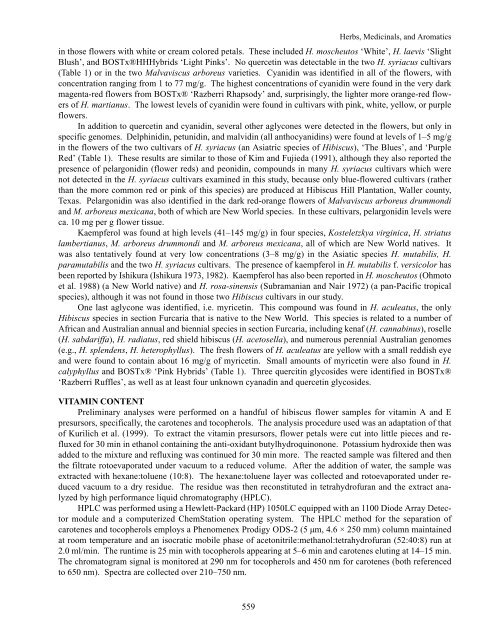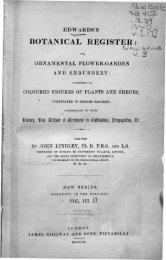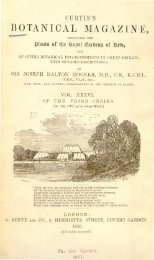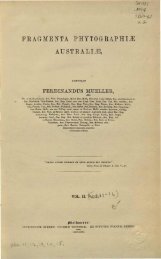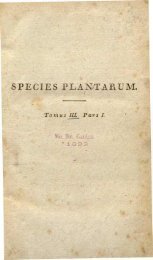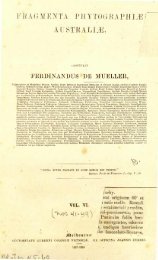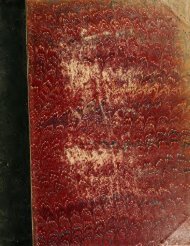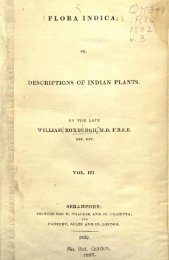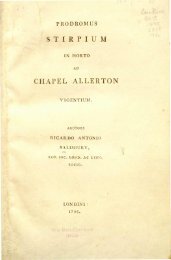Analyses for Flavonoid Aglycones in Fresh and Preserved Hibiscus ...
Analyses for Flavonoid Aglycones in Fresh and Preserved Hibiscus ...
Analyses for Flavonoid Aglycones in Fresh and Preserved Hibiscus ...
Create successful ePaper yourself
Turn your PDF publications into a flip-book with our unique Google optimized e-Paper software.
Herbs, Medic<strong>in</strong>als, <strong>and</strong> Aromatics<br />
<strong>in</strong> those flowers with white or cream colored petals. These <strong>in</strong>cluded H. moscheutos ‘White’, H. laevis ‘Slight<br />
Blush’, <strong>and</strong> BOSTx®HHHybrids ‘Light P<strong>in</strong>ks’. No quercet<strong>in</strong> was detectable <strong>in</strong> the two H. syriacus cultivars<br />
(Table 1) or <strong>in</strong> the two Malvaviscus arboreus varieties. Cyanid<strong>in</strong> was identified <strong>in</strong> all of the flowers, with<br />
concentration rang<strong>in</strong>g from 1 to 77 mg/g. The highest concentrations of cyanid<strong>in</strong> were found <strong>in</strong> the very dark<br />
magenta-red flowers from BOSTx® ‘Razberri Rhapsody’ <strong>and</strong>, surpris<strong>in</strong>gly, the lighter more orange-red flowers<br />
of H. martianus. The lowest levels of cyanid<strong>in</strong> were found <strong>in</strong> cultivars with p<strong>in</strong>k, white, yellow, or purple<br />
flowers.<br />
In addition to quercet<strong>in</strong> <strong>and</strong> cyanid<strong>in</strong>, several other aglycones were detected <strong>in</strong> the flowers, but only <strong>in</strong><br />
specific genomes. Delph<strong>in</strong>id<strong>in</strong>, petunid<strong>in</strong>, <strong>and</strong> malvid<strong>in</strong> (all anthocyanid<strong>in</strong>s) were found at levels of 1–5 mg/g<br />
<strong>in</strong> the flowers of the two cultivars of H. syriacus (an Asiatric species of <strong>Hibiscus</strong>), ‘The Blues’, <strong>and</strong> ‘Purple<br />
Red’ (Table 1). These results are similar to those of Kim <strong>and</strong> Fujieda (1991), although they also reported the<br />
presence of pelargonid<strong>in</strong> (flower reds) <strong>and</strong> peonid<strong>in</strong>, compounds <strong>in</strong> many H. syriacus cultivars which were<br />
not detected <strong>in</strong> the H. syriacus cultivars exam<strong>in</strong>ed <strong>in</strong> this study, because only blue-flowered cultivars (rather<br />
than the more common red or p<strong>in</strong>k of this species) are produced at <strong>Hibiscus</strong> Hill Plantation, Waller county,<br />
Texas. Pelargonid<strong>in</strong> was also identified <strong>in</strong> the dark red-orange flowers of Malvaviscus arboreus drummondi<br />
<strong>and</strong> M. arboreus mexicana, both of which are New World species. In these cultivars, pelargonid<strong>in</strong> levels were<br />
ca. 10 mg per g flower tissue.<br />
Kaempferol was found at high levels (41–145 mg/g) <strong>in</strong> four species, Kosteletzkya virg<strong>in</strong>ica, H. striatus<br />
lambertianus, M. arboreus drummondi <strong>and</strong> M. arboreus mexicana, all of which are New World natives. It<br />
was also tentatively found at very low concentrations (3–8 mg/g) <strong>in</strong> the Asiatic species H. mutabilis, H.<br />
paramutabilis <strong>and</strong> the two H. syriacus cultivars. The presence of kaempferol <strong>in</strong> H. mutabilis f. versicolor has<br />
been reported by Ishikura (Ishikura 1973, 1982). Kaempferol has also been reported <strong>in</strong> H. moscheutos (Ohmoto<br />
et al. 1988) (a New World native) <strong>and</strong> H. rosa-s<strong>in</strong>ensis (Subramanian <strong>and</strong> Nair 1972) (a pan-Pacific tropical<br />
species), although it was not found <strong>in</strong> those two <strong>Hibiscus</strong> cultivars <strong>in</strong> our study.<br />
One last aglycone was identified, i.e. myricet<strong>in</strong>. This compound was found <strong>in</strong> H. aculeatus, the only<br />
<strong>Hibiscus</strong> species <strong>in</strong> section Furcaria that is native to the New World. This species is related to a number of<br />
African <strong>and</strong> Australian annual <strong>and</strong> biennial species <strong>in</strong> section Furcaria, <strong>in</strong>clud<strong>in</strong>g kenaf (H. cannab<strong>in</strong>us), roselle<br />
(H. sabdariffa), H. radiatus, red shield hibiscus (H. acetosella), <strong>and</strong> numerous perennial Australian genomes<br />
(e.g., H. splendens, H. heterophyllus). The fresh flowers of H. aculeatus are yellow with a small reddish eye<br />
<strong>and</strong> were found to conta<strong>in</strong> about 16 mg/g of myricet<strong>in</strong>. Small amounts of myricet<strong>in</strong> were also found <strong>in</strong> H.<br />
calyphyllus <strong>and</strong> BOSTx® ‘P<strong>in</strong>k Hybrids’ (Table 1). Three quercit<strong>in</strong> glycosides were identified <strong>in</strong> BOSTx®<br />
‘Razberri Ruffles’, as well as at least four unknown cyanad<strong>in</strong> <strong>and</strong> quercet<strong>in</strong> glycosides.<br />
VITAMIN CONTENT<br />
Prelim<strong>in</strong>ary analyses were per<strong>for</strong>med on a h<strong>and</strong>ful of hibiscus flower samples <strong>for</strong> vitam<strong>in</strong> A <strong>and</strong> E<br />
presursors, specifically, the carotenes <strong>and</strong> tocopherols. The analysis procedure used was an adaptation of that<br />
of Kurilich et al. (1999). To extract the vitam<strong>in</strong> presursors, flower petals were cut <strong>in</strong>to little pieces <strong>and</strong> refluxed<br />
<strong>for</strong> 30 m<strong>in</strong> <strong>in</strong> ethanol conta<strong>in</strong><strong>in</strong>g the anti-oxidant butylhydroqu<strong>in</strong>onone. Potassium hydroxide then was<br />
added to the mixture <strong>and</strong> reflux<strong>in</strong>g was cont<strong>in</strong>ued <strong>for</strong> 30 m<strong>in</strong> more. The reacted sample was filtered <strong>and</strong> then<br />
the filtrate rotoevaporated under vacuum to a reduced volume. After the addition of water, the sample was<br />
extracted with hexane:toluene (10:8). The hexane:toluene layer was collected <strong>and</strong> rotoevaporated under reduced<br />
vacuum to a dry residue. The residue was then reconstituted <strong>in</strong> tetrahydrofuran <strong>and</strong> the extract analyzed<br />
by high per<strong>for</strong>mance liquid chromatography (HPLC).<br />
HPLC was per<strong>for</strong>med us<strong>in</strong>g a Hewlett-Packard (HP) 1050LC equipped with an 1100 Diode Array Detector<br />
module <strong>and</strong> a computerized ChemStation operat<strong>in</strong>g system. The HPLC method <strong>for</strong> the separation of<br />
carotenes <strong>and</strong> tocopherols employs a Phenomenex Prodigy ODS-2 (5 µm, 4.6 × 250 mm) column ma<strong>in</strong>ta<strong>in</strong>ed<br />
at room temperature <strong>and</strong> an isocratic mobile phase of acetonitrile:methanol:tetrahydrofuran (52:40:8) run at<br />
2.0 ml/m<strong>in</strong>. The runtime is 25 m<strong>in</strong> with tocopherols appear<strong>in</strong>g at 5–6 m<strong>in</strong> <strong>and</strong> carotenes elut<strong>in</strong>g at 14–15 m<strong>in</strong>.<br />
The chromatogram signal is monitored at 290 nm <strong>for</strong> tocopherols <strong>and</strong> 450 nm <strong>for</strong> carotenes (both referenced<br />
to 650 nm). Spectra are collected over 210–750 nm.<br />
559


